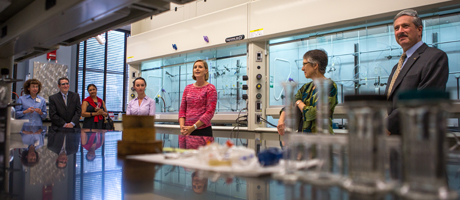The university last week took the wraps off a spacious and bright chemistry laboratory—carved from a former classroom deemed too hot, too cold and always too noisy—that officials hailed as a taste of the future flavor of lab science at GW.
“This is an exciting beginning,” Provost Steven Lerman told a crowd that gathered for an open house Tuesday evening at the new synthetic chemistry lab in Corcoran Hall.
“You’re going to be seeing more of these sorts of projects over the next several years, along with the construction of course of the signature facility, the Science and Engineering Hall,” said Dr. Lerman.
Chemistry Department Chair Michael King said renovating the former classroom offered an opportunity to model on a smaller scale the “new designs and new thinking” that are central to the Science and Engineering Hall project, from its air-handling system to work spaces geared toward the exchange of ideas.
The new space is now home to the labs of Cynthia Dowd and Adelina Voutchkova-Kostal. Both researchers’ work involves creating molecules: Dr. Dowd is developing new molecules to fight diseases, in particular tuberculosis, while Dr. Voutchkova-Kostal’s work is in making industrial processes less polluting and household products less toxic.
Though the researchers and equipment had moved in already, on Tuesday the space was still so new that it was virtually spotless. Rows of chemical hoods—glass-enclosed, ventilated work areas—looked like bright window displays decorated with spiraling glassware and bulbous beakers, occasionally bubbling liquid.
Countertop workspaces run alongside the chemical hoods, and in the entry a glass wall separates the lab from an open bank of desks and computers.
“We’re just so grateful that we can do our science in such a fabulous space,” said Dr. Dowd. She had reached the capacity of her old lab, she said, and the new space offered more room for students and for equipment that will increase productivity. The space also will be a “magnet” for prospective students and faculty, she said.
For Dr. Voutchkova-Kostal the move represents “the difference between being able to do the research that I was hired to do, and not being able to do it all.”
Since she arrived in January from Yale, she had been in lab space that accommodated only enough equipment to do “a small part of our research.”
“For me,” she said, “it means more than I could probably tell you in words to be able to actually see it in action finally. … It’s been just a huge boost in what we’re able to do. We’re very lucky.”
Corcoran Room 302 had long been a lecture hall but by the mid-2000s it was “just a mess,” said Dr. King, the department chair. Students sweltered in September and froze in December, taking final exams with their coats on, he said. Year-round, the “air-handling system for the room was so loud that you were horse by the end of a lecture.”
Eventually the university stopped holding classes in that room, he said. But from that untenable space, “now we have a fresh opportunity for cutting edge research.”
Among those viewing the lab were Chemistry Department alumnae Madeleine Jacobs, B.S. ’68, the executive director and chief executive officer of the American Chemical Society, and Nancy Jackson, B.S. ’79, the organization’s immediate past president.
Ms. Jacobs, who joined GW’s Board of Trustees in July, remembered taking a general chemistry course in Corcoran’s Room 302 during her freshman year. “It’s very exciting to see what is possible,” she said. “I’m thrilled by this transformation.”


